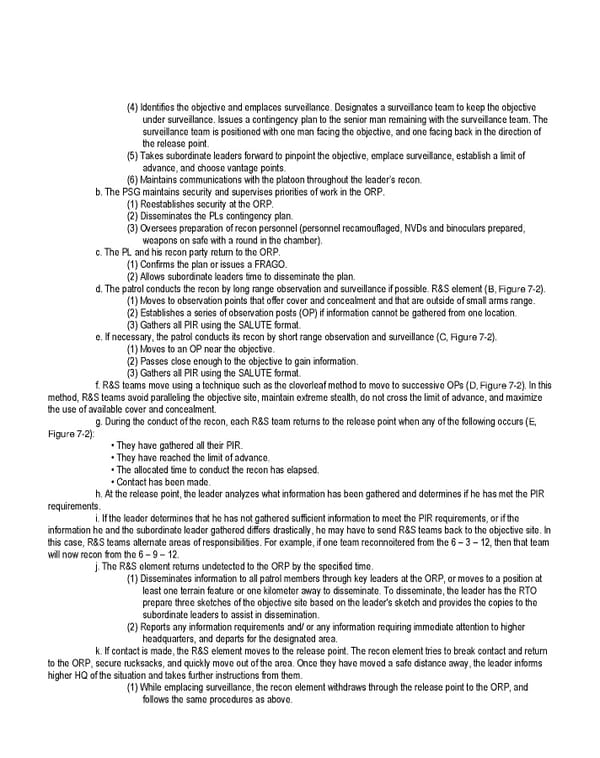(4) Identifies the objective and emplaces surveillance. Designates a surveillance team to keep the objective under surveillance. Issues a contingency plan to the senior man remaining with the surveillance team. The surveillance team is positioned with one man facing the objective, and one facing back in the direction of the release point. (5) Takes subordinate leaders forward to pinpoint the objective, emplace surveillance, establish a limit of advance, and choose vantage points. (6) Maintains communications with the platoon throughout the leader’s recon. b. The PSG maintains security and supervises priorities of work in the ORP. (1) Reestablishes security at the ORP. (2) Disseminates the PLs contingency plan. (3) Oversees preparation of recon personnel (personnel recamouflaged, NVDs and binoculars prepared, weapons on safe with a round in the chamber). c. The PL and his recon party return to the ORP. (1) Confirms the plan or issues a FRAGO. (2) Allows subordinate leaders time to disseminate the plan. d. The patrol conducts the recon by long range observation and surveillance if possible. R&S element (B, Figure 7-2). (1) Moves to observation points that offer cover and concealment and that are outside of small arms range. (2) Establishes a series of observation posts (OP) if information cannot be gathered from one location. (3) Gathers all PIR using the SALUTE format. e. If necessary, the patrol conducts its recon by short range observation and surveillance (C, Figure 7-2). (1) Moves to an OP near the objective. (2) Passes close enough to the objective to gain information. (3) Gathers all PIR using the SALUTE format. f. R&S teams move using a technique such as the cloverleaf method to move to successive OPs (D, Figure 7-2). In this method, R&S teams avoid paralleling the objective site, maintain extreme stealth, do not cross the limit of advance, and maximize the use of available cover and concealment. g. During the conduct of the recon, each R&S team returns to the release point when any of the following occurs (E, Figure 7-2): • They have gathered all their PIR. • They have reached the limit of advance. • The allocated time to conduct the recon has elapsed. • Contact has been made. h. At the release point, the leader analyzes what information has been gathered and determines if he has met the PIR requirements. i. If the leader determines that he has not gathered sufficient information to meet the PIR requirements, or if the information he and the subordinate leader gathered differs drastically, he may have to send R&S teams back to the objective site. In this case, R&S teams alternate areas of responsibilities. For example, if one team reconnoitered from the 6 – 3 – 12, then that team will now recon from the 6 – 9 – 12. j. The R&S element returns undetected to the ORP by the specified time. (1) Disseminates information to all patrol members through key leaders at the ORP, or moves to a position at least one terrain feature or one kilometer away to disseminate. To disseminate, the leader has the RTO prepare three sketches of the objective site based on the leader's sketch and provides the copies to the subordinate leaders to assist in dissemination. (2) Reports any information requirements and/ or any information requiring immediate attention to higher headquarters, and departs for the designated area. k. If contact is made, the R&S element moves to the release point. The recon element tries to break contact and return to the ORP, secure rucksacks, and quickly move out of the area. Once they have moved a safe distance away, the leader informs higher HQ of the situation and takes further instructions from them. (1) While emplacing surveillance, the recon element withdraws through the release point to the ORP, and follows the same procedures as above.
 Ranger Handbook Page 117 Page 119
Ranger Handbook Page 117 Page 119